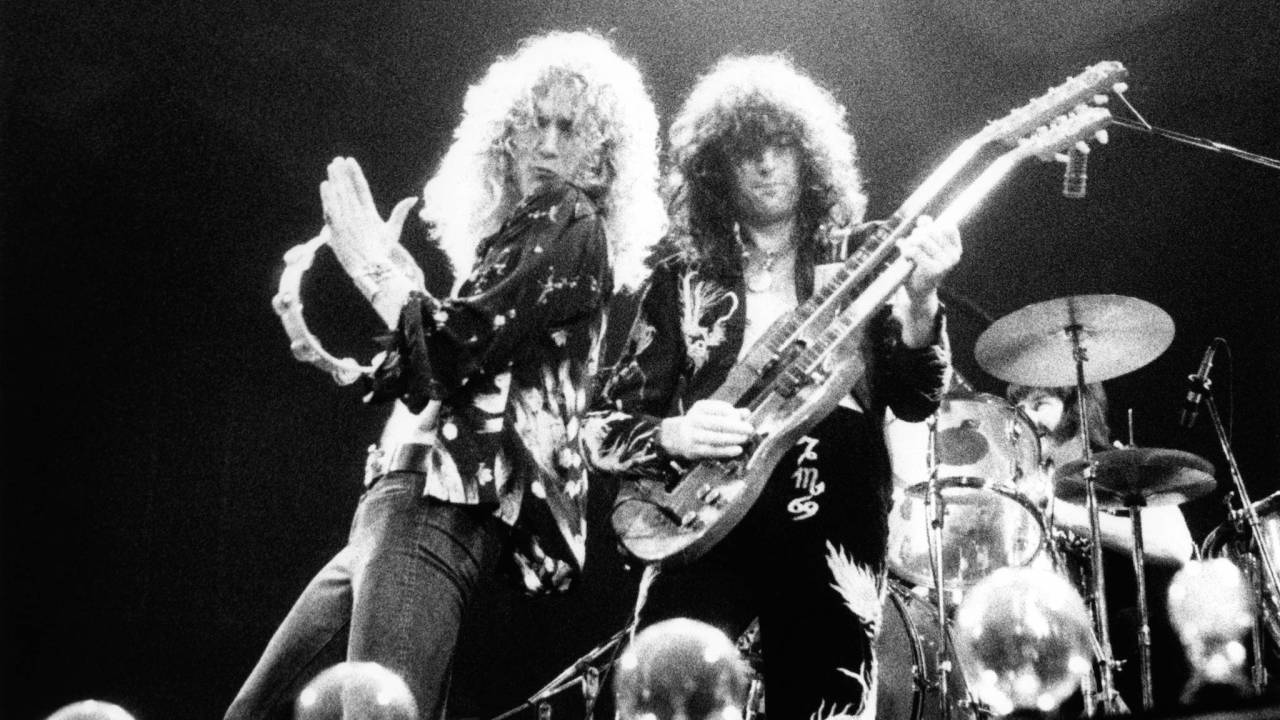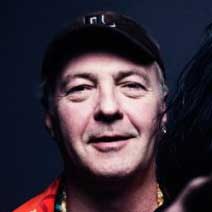You can trust Louder
Why is this possibly the greatest double album ever made? Why indeed. There’s a feral mystery to it even today, that still defies description, nevertheless we like the impossible. Let’s have a go, shall we?
Custard Pie lets us know what we’re in for. A menacing and salacious riff, dripping with intoxicating dirty blues lust opens the door to a Dionysian orgy, writhing with desire, revelling in its own relentless pursuit of pleasure. The unapologetic mutant funk rhythm section of Bonzo Bonham and John Paul Jones buffalos a path through the fray. Wha-wha clavinet snakes around your hips and spins you around. It’s primitive voodoo.
Razor-sharp guitars slash and burn, shredding and mangling your sensibilities. Robert Johnson, chicken blood and smoking valve amps are all invoked and teleported into leafy Barnes’ Olympic Studio 2 (amongst other locations). Inside, it’s aural carnage.
We get the beautiful Bron-Yr-Aur next, a gorgeous acoustic jig resuscitated from earlier sessions in 1970. It’s wistful and boasts a delicate beauty again reminiscent of Celtic/Vedic correspondence: its Raga-like open tuning, obviously pioneered and influenced by Davey Graham and Bert Jansch, but given a unique reinterpretation from Page within a strong melodic structure that strengthens the overall dynamics of the album.
The remastering, by Led Zeppelin veteran John Davies, is clearly apparent on this release. Remastering is important here. Though the band’s past CD releases saw some terrible mastering crimes committed against humanity the digital package I’m reviewing from here does sound great - warm and lush - on my home system. The vinyl sounds amazing and reveals that the mastering is certainly better than ever before, with more sub and lots of clarity. It’s also reassuringly heavy to hold.
Down By The Seaside, again a little light pop flavoured digression, is a little bit Beach Boys with Doo Wop backing vocals. Although its genesis was acoustic and influenced by Neil Young, it comes over more whimsical-Faces/Stones-like: the middle eight changes gear and it kicks off with some real verve. Page excels again. This really reminds me of waiting for school to finish during the long summer of ‘75.
When I listen to Ten Years Gone now it’s still spellbinding. Our astronaut alchemists nearing the end of their quest, heroin-soaked, cocaine-addled. Lost in the desert, wheels spinning in the sand. The struggle is beating them down, you can hear the weariness in the voice and beats, the end is near. It is prophetic, as nothing the band recorded subsequently would again match these heights.
Sign up below to get the latest from Classic Rock, plus exclusive special offers, direct to your inbox!
Night Flight is another rescued outtake from ‘71 that, despite out of tune guitars, swaggers along like a maliciously strutting droog. These b-side ‘throw aways’ would be other bands’ lead tracks… staggering.
The Wanton Song is another anthem to female sexual promiscuity. A killer beat, arc welded to a filthy riff. Dirty, gravelly, soulful howls are exorcised from Plant, superb reversed guitars and a bridge that reminds me of Ace’s How Long, a great Lesley rotating speaker cabinet guitar overdub and a slick-wristed, psychedelic flowerpop solo. This is Zeppelin at their solstice zenith, and maybe their most influential track, but it’s all down hill from here.
Boogie With Stu is a lighthearted jam that evokes an image of the band on a day off in a New Orleans Bordello with the Stones’ Ian Stewart woogie-ing away at a 1920’s ragtime piano. It’s quite Bolan-esque really, but where it leads us is to the incredible Black Country Woman. “Shall we roll it, Jimmy?” asks a young Eddie Kramer as they’re captured recording al fresco in Mick Jagger’s Stargroves garden in ‘72. You can hear an airplane flying overhead.“Nah, leave it,” replies Page with a nonchalant chuckle. I love the way they leave that on, like a current hipster field recording. Its intimacy is prophetic. Bonham’s four-to-the-floor kick and twisted Beefheart break smashes this otherwise ordinary acoustic, country blues stomp.
Sick Again: “Through the circus of the LA queens”. Ten long years of on the road decadence and way too much impersonal sex with teenage groupies had taken its toll. They sound tired. Although I love the way Page generally mixed Plant’s vocals down into the mix, allowing the listener to investigate and get involved with the recording, to be able to work out, or even reinvent, what the lyric is. “Teenage dreams already old at 16”. This really is the end. Though fate prophetically points her finger to the new barbarians storming the rock citadel… Punk.
This is the last track on the album. The intro riff sounds spirited, like early Damned, but then the track kicks in and is ponderous and over-produced, too many overdubs. Halfway through there’s a shot of adrenaline administered and they all pick it up, but just a bit. Punk was something not even Zeppelin could have predicted or even withstood. (Punk’s zeitgeist within a year or two would make the band suddenly look and sound old, slow and cumbersome). Despite its failings (the demo is a lot more Beatles-like and lively) the track and album does end beautifully, on a solo reversed guitar dubbed up with echo and ominously, a prophetic Pistols-like pick scrape.
Just one year later, when I was 15 in 1976, the Job Centre in Fulham sent me to 484, King Road, Chelsea for an interview as a runner at Swansong, the band’s own record label. I couldn’t believe my luck… but it didn’t last long, as I made the fatal mistake of wearing a Zep vest and declaring my fanboy credentials to the receptionist. My interview was a cursory glance and grunt from Peter Grant and I was ushered unceremoniously out the door.
Skip to 1982, I am 21, a bona fide cult hero, a rock star with hit albums and a sizeable following, standing outside the very same Kings Road door (this area of Chelsea is ironically called World’s End) in a Biblical thunder and lightning rainstorm. Way too much Sorcerer’s Apprentice LSD and excessive touring has resulted in my own meltdown. My body is producing industrial strength DMT that is coursing through my blood… I am the walrus. I had gone from Sid Vicious to Syd Barrett in one quick amphetamine-fuelled, psychedelic dystopian summer. Everything had become cosmic and heavy. Like Joseph Campbell meeting Terence McKenna in a scene from The Omen.
Tired and emotional, I made the solitary shamanic pilgrimage back to where it started. “I know what you’re up too!” I screamed at the unanswered door, “It’s all black magic!”. I shouted feebly past the marble lions outside the door, which mockingly roared silent curses into my drug-fevered, abyss-like eye sockets. Ravens cawed above and the wind howled. Luckily, Mr Grant was in a kindly sympathetic mood that day. I was recognised and Peter rang my manager, Mr Fenwick at EG Management (another exclusive boutique management agency who also represented Killing Joke, Roxy Music, Eno and King Crimson and whose offices were only just a little further up the Kings Road).
“Come and get yer boy before we break his bones”. (Must have been some bizarre pirates’ honour of rock management etiquette and courtesy that dictated they didn’t break my bones before ringing EG up). Five minutes later and Mr Fenwick’s vintage Bentley purrs up alongside and gently but firmly, like at the end of the movie Performance, where James Fox is bundled off, I’m being whisked inside.
“That was close, Youth,” exclaims Mark Fenwick with a nervous chuckle (he still manages Roger Waters). “What were you thinking…? ” Love is the law.

Those Bonus Tracks In Full
Brandy & Coke (Trampled Under Foot - Initial Rough Mix)
On this early version of Trampled Under Foot, the dizzying interplay between John Bonham and John Paul Jones on the clavinet underscores what far too many fail to grasp, which is that Led Zeppelin were the funkiest hard rock band of the 70s. Stripped of post-production effects and bristling with swagger, this fiendishly danceable blowout invites close comparisons to chart-topping disco acts such as K.C. & The Sunshine Band.
Sick Again (Early Version)
Before morphing into a caustic rebuke of LA’s teenage groupies, Sick Again began as this bare-knuckled pentatonic free-for-all, sizzling with Jimmy Page’s funk-infused slide and Bonham’s propulsive triplets. Clocking in at just over two minutes and without Robert Plant’s vocals, this version is the most fragmentary of the bonus tracks.
In My Time Of Dying (Initial Rough Mix)
The framework for the album version is almost entirely in place on this rough mix, although the breathtaking interplay between Jones, Page and Bonham building up to the climax enjoys a bracing new clarity. This version also highlights Bonzo’s signature style of locking in with Page’s riffing rather than cleaving to repeating metronomic time signatures.
Houses Of The Holy (Rough Mix with Overdubs)
While the debate raged on as to whether or not Stairway To Heaven concealed hidden Satanic messages, the song Houses Of The Holy contained not one but two overt references to the Prince Of Darkness. Here on the rough mix, the second of these lyrics — ‘Satan and man’ — is missing. Otherwise, apart from modest overdubs, this mix hews closely to the album version.
Everybody Makes It Through (In The Light Early Version/In Transit)
The most radical departure from its finished counterpart, this early take on In the Light begins with a baroque harpsichord passage rather than the two minutes of pseudo-futuristic synths that open the album version. Also featuring alternate lyrics and brighter dynamics from Page, this version is brooding, sparsely-rendered and utterly absorbing.
Boogie With Stu (Sunset Sound Mix)
In 1971, longtime Stones tour manager and keyboardist Ian “Stu” Stewart turned up at Headley Grange, where Zep were recording IV. A boozy, free-flowing jam ensued, featuring Stu on piano, Robert on guitar and Jimmy on mandolin. In this mix, Stu’s part is brought front and centre – a subtle, but appreciable tweak that amplifies the driving Dixieland blues vibe that Stu so dearly loved.
Driving Through Kashmir (Kashmir Rough Orchestra Mix)
The mesmerising groove that underpins Zeppelin’s crowning moment materialised during a jam session between Bonham and Page, but it would be the imperious orchestral backdrop that would cement the song’s iconic status. On this rough mix, the brass and strings are at the fore, revealing subtle accents and softer flourishes that are difficult to hear in the final version.
By Joe Daly
Martin Glover, better known by his stage name Youth, is a British record producer, musician DJ and poet, best known as a founding member and bassist of the rock band Killing Joke. Among his production credits are Crowded House, The Cult, The Orb, Pink Floyd, The Verve and U2. He is also a member of the Fireman, along with Paul McCartney.


